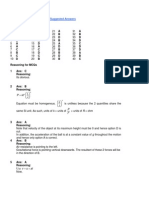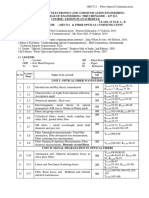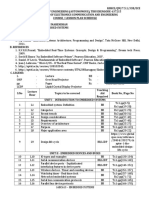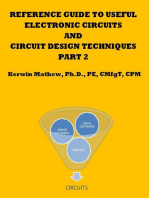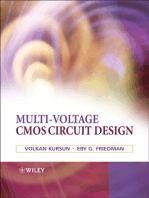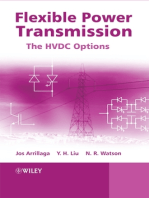0 ratings0% found this document useful (0 votes)
8 viewsLesson plan qb EMP
Uploaded by
VeeramaniCopyright
© © All Rights Reserved
Available Formats
Download as DOCX, PDF, TXT or read online on Scribd
0 ratings0% found this document useful (0 votes)
8 viewsLesson plan qb EMP
Uploaded by
VeeramaniCopyright
© © All Rights Reserved
Available Formats
Download as DOCX, PDF, TXT or read online on Scribd
You are on page 1/ 7
OBJECTIVE(S):
To learn the fundamental concepts of semiconductor device.
To understand the fundamental concepts of Digital Electronics.
To gain knowledge about 8085 microprocessors and its applications
UNIT I SEMICONDUCTORS AND RECTIFIERS 9Hrs
Classification of solids based on energy band theory-Intrinsic semiconductors-Extrinsic semiconductors-
PN junction diode: characteristics-Half wave and full wave rectifiers - Zener diode: Characteristics -
voltage regulator
UNIT II TRANSISTORS AND AMPLIFIERS 9Hrs
Bipolar junction transistor construction and Characteristic - CE configuration and characteristics-
Transistor biasing: Fixed and voltage divider biasing -Class A, B and C amplifiers- construction and
characteristics: FET, SCR and UJT-Concept of feedback: negative feedback- application in temperature
and motor speed control
UNIT III DIGITAL ELECTRONICS 9Hrs
Number system: -Binary, Octal, Hexadecimal-Boolean algebra – logic gates- half and full adder-flip
flops-shift register: SISO, SIPO, PIPO- Counters: 3-Bit Synchronous up&down,3-bit asynchronous up &
down – A/D conversion: single slope, successive approximation – D/A conversion binary weighted
register type.
UNIT IV 8085 MICROPROCESSOR 9Hrs
Block diagram of microcomputer - 8085: Architecture pin configuration, addressing modes, instruction
set and Simple programs using arithmetic and logical operations.
UNIT V INTERFACING AND APPLICATIONS OF MICROPROCESSOR 9Hrs
Basic interfacing concepts - Interfacing of Input and output devices-Applications of microprocessor.
Temperature control - Stepper motor control - Traffic light control - case study: mining problem -
turbine monitor using 8085
TOTAL: 45 PERIODS
TEXT BOOKS
1. Milman and Halkias, “Integrated Electronics”, Tata McGraw-Hill publishers, 2 nd Edition, 2011
2. Ramesh Goankar, “Microprocessor Architecture”, Programming and Applications with 8085, 5 th
Edition, Wiley Eastern, 2011.
REFERENCES
1. Malvino and Leach, “Digital Principles and Applications”, Tata McGraw-Hill, 5 th Edition, 2006.
2. Mehta V.K, “Principles of Electronics”, S. Chand and Company Ltd., 2009.
3. Salivahanan S, Suresh Kumar N, Vallavaraj A, “Electronic Devices and Circuits” Tata
McGraw-Hill, 2nd Edition, 2008.
4. Krishna kant “Microprocessors and Microcontrollers”, PHI Learning private ltd., 2011.
CLASS : III B. E (MECH A, B, C&D)
SUBJECT : 12EC3625- ELECTRONICS AND MICROPROCESSOR
A). TEXT BOOKS:
1. Milman and Halkias, “Integrated Electronics”, Tata McGraw-Hill publishers, 2 nd
Edition, 2011
2. Ramesh Goankar, “Microprocessor Architecture”, Programming and Applications with
8085, 5th Edition, Wiley Eastern, 2011.
B). REFERENCE BOOKS:
1. Malvino and Leach, “Digital Principles and Applications”, Tata McGraw-Hill, 5 th
Edition, 2006.
2. Mehta V.K, “Principles of Electronics”, S. Chand and Company Ltd., 2009.
3. Salivahanan S, Suresh Kumar N, Vallavaraj A, “Electronic Devices and Circuits”
Tata McGraw-Hill, 2nd Edition, 2008.
4. Krishna kant “Microprocessors and Microcontrollers”, PHI Learning private ltd., 2011.
B). LEGEND:
L - Lecture OHP - Over Head Projector
T - Tutorial BB - Black Board
Tx - Text Book Rx - Reference Book
Sl. Lecture Teaching Aid Book No./Page
Topics to be covered
No Hour Required No
UNIT I SEMICONDUCTORS AND RECTIFIERS
Classification of solids based on energy TX1/pp 14-17
1 L1 BB
band theory RX2/pp 55-59
TX1/pp 24-29
2 L2 Intrinsic semiconductors BB
RX2/pp 62-65
TX1/pp 24-29
3 L3 Extrinsic semiconductors BB
RX2/pp 62-65
TX1/pp 49-61
4 L4 PN junction diode BB RX2/pp 66-73
RX2/pp 77-80
Characteristics-Half wave and full wave TX1/pp 103-109
5 L5 BB
rectifiers RX2/pp 87-95
Zener diode: Characteristics TX1/pp 73-77
6 L6 L7 BB
RX2/pp 108-112
7 L8,L9 Voltage regulation BB RX2/pp 446-452
UNIT II TRANSISTORS AND AMPLIFIERS
Bipolar junction transistor construction TX1/pp 118-121
8 L10 BB
and Characteristic RX2/pp 142-163
TX1/pp 126-139
L11
9 CE configuration and characteristics BB RX2/pp 160-162
L12
RX3/pp 284-296
Transistor biasing: Fixed and voltage
10 L13 BB TX1/pp 301-302
divider biasing
RX2/pp 227-330
L14
11 Class A, B and C amplifiers BB RX2/pp 307-321
RX3/pp 428-443
TX1/pp 335-339
TX1/pp 712-715
RX2/pp 227-229
L15 construction and characteristics: FET,
12 BB RX2/pp 235-238
L16 SCR and UJT
RX2/pp 507-513
RX2/pp 555-559
RX3/pp 197-226
L17 TX1/pp 410-416
13 Concept of feedback: negative feedback BB
RX2/pp 235-239
Application in temperature and motor
14 L18 BB TX1/pp 647
speed control
UNIT III DIGITAL ELECTRONICS
RX1/pp 176-195
Number system: -Binary, Octal,
15 L19 BB RX2/pp 730-195
Hexadecimal-Boolean algebra
RX3/pp 851-861
16 L20 Logic gates- half and full adder BB RX1/pp 40-61
RX1/pp 230-235
RX2/pp 738-747
RX3/pp 864-869
RX1/pp 309-331
Flip flops-shift register-Serial In Serial
17 L21 BB RX1/pp 273-298
Out
RX3/pp 884-887
Serial In Parallel Out, Parallel In RX1/pp 309-331
18 L22 BB
Parallel Out RX3/pp 887-890
RX1/pp 339-376
19 L23 L24 Counters: 3-Bit Synchronous up&down BB
RX3/pp 890-893
RX1/pp 339-376
20 L25 3-bit asynchronous up & down BB
RX3/pp 890-893
A/D conversion: single slope, successive RX1/pp 440-466
21 L26 BB
approximation RX3/pp 893-899
D/A conversion binary weighted register RX1/pp 440-466
22 L27 OHP
type RX3/pp 893-899
UNIT IV 8085 MICROPROCESSOR
23 L28 Block diagram of microcomputer BB TX2/pp 109-116
24 L39 8085: Architecture OHP TX2/pp 105-108
25 L30 Pin configuration OHP TX2/pp 96-105
L31 L32
26 Addressing modes BB Tx2/pp 179
L33
27 L34 Instruction set BB TX2/pp 35-42
TX2/pp 43-46,
L35 Simple programs using arithmetic and
28 BB 186-196
L36 logical operations
& 196-204
UNIT V INTERFACING AND APPLICATIONS OF MICROPROCESSOR
29 L37 L38 Basic interfacing concepts BB TX2/pp 140-150
L39 L40
30 Interfacing of Input and Output devices BB TX2/pp 150-156
L41
Applications of microprocessor
31 L42 L43 OHP TX2/pp 24-26
Temperature control.
32 L44 Stepper motor control OHP RX4/pp 667-671
33 L45 Traffic light control OHP RX4/pp 644-649
Unit I SEMICONDUCTORS AND RECTIFIERS
1. What are valence electrons?
Electron in the outer most shell of an atom is called valence electron.
2. What is forbidden energy gap?
The space between the valence and conduction band is said to be forbidden energy gap.
3. What are conductors? Give examples?
Conductors are materials in which the valence and conduction band overlap each other so there is a
swift movement of electrons which leads to conduction. Ex. Copper, silver.
4. What are insulators? Give examples?
Insulators are materials in which the valence and conduction band are far away from each other. So
no movement of free electrons and thus no conduction. Ex glass, plastic.
5. What are Semiconductors? Give examples?
The materials whose electrical property lies between those of conductors and insulators are
known as Semiconductors. Ex germanium, silicon.
6. What are the types of Semiconductor?
1. Intrinsic semiconductor 2. Extrinsic semiconductor.
7. What is Intrinsic Semiconductor?
Pure form of semiconductors are said to be intrinsic semiconductor. Ex germanium, silicon.
8. What is Extrinsic Semiconductor?
If certain amount of impurity atom is added to intrinsic semiconductor the resulting
semiconductor is Extrinsic or impure Semiconductor.
9. What are the types of Extrinsic Semiconductor?
1. P-type Semiconductor 2. N- Type Semiconductor.
10. What is P-type Semiconductor?
The Semiconductor which are obtained by introducing pentavalent impurity atom (phosphorous,
antimony) are known as P-type Semiconductor.
11. What is N-type Semiconductor?
The Semiconductor which are obtained by introducing trivalent impurity atom (gallium, indium)
are known as N-type Semiconductor.
12. What is doping?
Process of adding impurity to an semiconductor atom is doping. The impurity is called dopant.
13. Which is majority and minority carrier in N-type Semiconductor?
Majority carrier: electrons and minority carrier: holes.
14. Which is majority and minority carrier in P-type Semiconductor?
Majority carrier: holes and minority carrier: electrons.
15. What is depletion region in PN junction?
The diffusion of holes and electrons will result in difference in concentration across the junction
which in turn results in the movement of the mobile charge carriers to the junction thus resulting in
a region called depletion region.
16. What is barrier voltage?
Because of the oppositely charged ions present on both sides of PN junction an electric
potential is established across the junction even without any external voltage source which is
termed as barrier potential.
17. What is meant by biasing a PN junction?
Connecting a PN junction to an external voltage source is biasing a PN junction.
18. What are the types of biasing a PN junction?
1. Forward bias 2. Reverse bias.
19. What is forward bias and reverse bias in a PN junction?
When positive of the supply is connected to P type and negative to N type then it is forward bias.
When positive of the supply is connected to N type and negative to P type then it is reverse bias.
20. What is Reverse saturation current?
The current due to the minority carriers in reverse bias is said to be reverse saturation current.
21. What is reverse break down?
During reverse bias after certain reverse voltage the current through the junction increases
abruptly thus breaking the crystal which is termed as reverse break down.
22. Give the diode current equation?
I = I0. (e -1)
23. Give two applications of PN junction diode.
1. As rectifier in power supplies.
2. as switch in logic circuits
24. What is rectifier? Give its types.
Rectifier converts A.C to pulsating D.C. Types are HWR and FWR.
16 MARKS
25. Explain N-type and P-type semiconductor with their energy band diagram?
Maximum mark for this question: 8 marks Definition of extrinsic semiconductor and its types (2
marks) N-type semiconductor (3marks)Definition
Diagram of crystalline structure and energy band (2 marks) P-type semiconductor (3marks) Definition,
Diagram of crystalline structure and energy band (2 marks)
26. Explain the following
a. Mobility b. Drift current c. Conductivity d. Diffusion current
Maximum mark for this question: 12 marks mobility - definition and relation required (2 marks)
a. Drift current – definition, diagrams and derivation of relation required (4marks)
b. Conductivity - definition and relation required (2 marks)
c. Diffusion current - definition, diagrams and derivation of relation required (4marks)
27. What is break down in diode? What are its types?
Maximum mark for this question: 6 marks Definition of break down and explanation (2 marks)
Zener break down (2 marks) Avalanche break down (2 marks).
Unit II TRANSISTORS AND AMPLIFIERS
1. What is a transistor (BJT)?
Transistor is a three terminal device whose output current, voltage and /or power are controlled
by input current.
2. What are the terminals present in a transistor?
Three terminals: emitter, base, collector.
3. What is FET?
FET is abbreviated for field effect transistor. It is a three terminal device with its output
characteristics controlled by input voltage.
4. Why FET is called voltage controlled device?
The output characteristics of FET is controlled by its input voltage thus it is voltage controlled.
5. What are the two main types of FET?
1. JFET 2. MOSFET.
6. What are the terminals available in FET?
1. Drain 2. Source 3. Gate
7. What is JFET?
JFET- Junction field effect transistor.
8. What are the types of JFET?
N- channel JFET and P- Channel JFET
9. What are the two important characteristics of JFET?
1. Drain characteristics 2. Transfer characteristics.
10. What is transconductance in JFET?
It is the ratio of small change in drain current to he corresponding change in drain to source
voltage.
11. What is amplification factor in JFET?
It is the ratio of small change in drain to source voltage to the corresponding change in Gate
to source voltage.
12.Why do we choose q point at the center of the loadline?
The operating point of a transistor is kept fixed usually at the center of the active region in order
that the input signal is well amplified. If the point is fixed in the saturation region or the cut off
region the positive and negative half cycle gets clipped off respectively.
13. List out the different types of biasing. ._
Voltage divider bias ,Base bias,Emitter feed back bias,Collector feedback bias,Emitter bias.
14. What do you meant by thermal runway?
Due to the self heating at the collector junction, the collector current rises. This causes damage
to the device. This phenomenon is called thermal runway.
15. Why is the transistor called a current controlled device?
The output characteristics of the transistor depend on the input current. So the transistor is
called a current controlled device.
16. Define current amplification factor?
It is defined as the ratio of change in output current to the change in input current at constant.
17. What are the requirements for biasing circuits?
The q point must be taken at the Centre of the active region of the output
characteristics.
Stabilize the collector current against the temperature variations.
Make the q point independent of the transistor parameters.
When the transistor is replaced, it must be of same type.
18. When does a transistor act as a switch?
The transistor acts as a switch when it is operated at either cutoff region or saturation region
19. What is biasing?
To use the transistor in any application it is necessary to provide sufficient voltage and current to
operate the transistor. This is called biasing.
20. What is stability factor?
Stability factor is defined as the rate of change of collector current with respect to the rate of
change of reverse saturation current.
21. Explain about the various regions in a transistor?
The three regions are active region saturation region cutoff region.
22. Explain about the characteristics of a transistor?
Input characteristics: it is drawn between input voltage & input current while keeping output voltage
as constant.
Output characteristics: It is drawn between the output voltage &output current while keeping input
current as constant.
16 MARKS
23. Explain the construction, operation, volt ampere characteristics, and application of SCR, also
explain its two transistor model.
Maximum mark for this question: 16 marks Construction (2marks)
Equivalent circuit and two transistor model (2marks) Operation (4marks)
Volt ampere characteristics (4marks) Application (2marks)
24. Explain the construction, operation, equivalent circuit, volt ampere characteristics, and
application of UJT.
Maximum mark for this question: 16 marks Construction (4marks) Equivalent circuit (2marks)
Operation (4marks) Volt ampere characteristics (4marks) Application (2marks)
25. Explain the construction, operation, equivalent circuit, volt ampere characteristics, and
application of DIAC.
Maximum mark for this question: 16 marks Construction (4marks)
Equivalent circuit (2marks) Operation (4marks) Volt ampere characteristics (4marks) Application
(2marks)
26. Explain the construction, operation, equivalent circuit, volt ampere characteristics, and
application of TRIAC
Maximum mark for this question: 16 marks Construction (4marks) Equivalent circuit (2marks) Operation
(4marks) Volt ampere characteristics (4marks) Application (2marks)
Unit III DIGITAL ELECTRONICS
1. Define binary logic?
Binary logic consists of binary variables and logical operations. The variables are designated by the
alphabets such as A, B, C, x, y, z, etc., with each variable having only two distinct values: 1 and 0.
There are three basic logic operations: AND, OR, and NOT.
2. Convert (634) 8 to binary
634 = 110 011 100 Ans = 110011100
3. Convert 0.640625 decimal numbers to its octal equivalent.
0.640625 x 8 = 5.125
0.125 x 8 = 1.0
0.640 625 10 = (0.51) 8
4. Convert 0.1289062 decimal number to its hex equivalent
0.1289062 x 16 = 2.0625
0.0625 x 16 = 1.0
0.1289062 = (0.21) 16
5. Substract (0 1 0 1) 2 from (1 0 1 1) 2
1010
0101
Answer = 0 1 1 0
6. Add (1 0 1 0) 2 and (0 0 1 1) 2
1010
0011
Answer = (1 1 0 1) 2
7. Using 10’s complement subtract 72532 - 3250
M = 72532
10’s complement of N = + 96750 Sum = 169282
Discard end carry Answer = 69282
8. Find 2’S complement of (1 0 1 0 0 0 1 1) 2
0 1 0 1 1 1 0 0 1 - 1’s Complement + 1 0 1 0 1 1 1 0 1 0 -
2’s complement.
9. Substract 1 1 1 0 0 1 2 from 1 0 1 0 1 1 2 using 2’ s complement method
You might also like
- All Questions and Answers of Fiber Optic NetworkNo ratings yetAll Questions and Answers of Fiber Optic Network29 pages
- Materi 7 - Parameter Cell Site Design 2024No ratings yetMateri 7 - Parameter Cell Site Design 202411 pages
- SECTION 3.3.8 PAGE 114 OF 172: Section 3.3.8 - Protection Indication System R4No ratings yetSECTION 3.3.8 PAGE 114 OF 172: Section 3.3.8 - Protection Indication System R421 pages
- E Engineering The Rybaby Style Wah PedalNo ratings yetE Engineering The Rybaby Style Wah Pedal35 pages
- 30 Flexi RRH 2-Pipe 900 80W (FHDA) : Functional DescriptionNo ratings yet30 Flexi RRH 2-Pipe 900 80W (FHDA) : Functional Description5 pages
- IEEE 802.3bj: 100GBASE-CR4 Specifications Minneapolis, MN May 2012No ratings yetIEEE 802.3bj: 100GBASE-CR4 Specifications Minneapolis, MN May 201224 pages
- Product Profile: MMIC Wideband Medium Power AmplifierNo ratings yetProduct Profile: MMIC Wideband Medium Power Amplifier14 pages
- Dismantled POQ Template: Good/Broken/DamageNo ratings yetDismantled POQ Template: Good/Broken/Damage3 pages
- Block Diagram: TX B1/B2/B3/B5/B7/B8/ B34/B39/B40/B41No ratings yetBlock Diagram: TX B1/B2/B3/B5/B7/B8/ B34/B39/B40/B417 pages
- ZD553KL RF Hardware Trouble Shooting Guide 20170707No ratings yetZD553KL RF Hardware Trouble Shooting Guide 2017070753 pages
- Sse - Acdb - 1 It-1 320 KW Acjb (80Kwx4) (4 in 2 Out)No ratings yetSse - Acdb - 1 It-1 320 KW Acjb (80Kwx4) (4 in 2 Out)3 pages
- Fundamentals of Electronics 1: Electronic Components and Elementary FunctionsFrom EverandFundamentals of Electronics 1: Electronic Components and Elementary FunctionsNo ratings yet
- Heterojunction Bipolar Transistors for Circuit Design: Microwave Modeling and Parameter ExtractionFrom EverandHeterojunction Bipolar Transistors for Circuit Design: Microwave Modeling and Parameter ExtractionNo ratings yet
- Reference Guide To Useful Electronic Circuits And Circuit Design Techniques - Part 2From EverandReference Guide To Useful Electronic Circuits And Circuit Design Techniques - Part 2No ratings yet
- ECE 028 - Electronic Devices and Circuits (LEC) - WM-2No ratings yetECE 028 - Electronic Devices and Circuits (LEC) - WM-2230 pages
- Bhaskaran Muralidharan Dept. of Electrical Engineering, Indian Institute of Technology BombayNo ratings yetBhaskaran Muralidharan Dept. of Electrical Engineering, Indian Institute of Technology Bombay23 pages
- 12th Chemistry 1-16 All Chapters Exercise SolutionNo ratings yet12th Chemistry 1-16 All Chapters Exercise Solution325 pages
- Aluminum Doped Silicon Carbide Thin Films Prepared by Hot-Wire CVD Influence ofNo ratings yetAluminum Doped Silicon Carbide Thin Films Prepared by Hot-Wire CVD Influence of3 pages
- Unit 1 The Solid State - MCQs (12th) - Chemistry - Objective Questions - 12th - Bihar Board (English Medium)No ratings yetUnit 1 The Solid State - MCQs (12th) - Chemistry - Objective Questions - 12th - Bihar Board (English Medium)13 pages
- (Macmillan Engineering Series) William F. Waller AMITPP AssIRefEng (Eds.) - Rectifier Circuits-Macmillan Education UK (1972)No ratings yet(Macmillan Engineering Series) William F. Waller AMITPP AssIRefEng (Eds.) - Rectifier Circuits-Macmillan Education UK (1972)135 pages
- Transducers Notes For Cape Physics Unit 2 Module2No ratings yetTransducers Notes For Cape Physics Unit 2 Module220 pages
- SECTION 3.3.8 PAGE 114 OF 172: Section 3.3.8 - Protection Indication System R4SECTION 3.3.8 PAGE 114 OF 172: Section 3.3.8 - Protection Indication System R4
- 30 Flexi RRH 2-Pipe 900 80W (FHDA) : Functional Description30 Flexi RRH 2-Pipe 900 80W (FHDA) : Functional Description
- IEEE 802.3bj: 100GBASE-CR4 Specifications Minneapolis, MN May 2012IEEE 802.3bj: 100GBASE-CR4 Specifications Minneapolis, MN May 2012
- Product Profile: MMIC Wideband Medium Power AmplifierProduct Profile: MMIC Wideband Medium Power Amplifier
- Block Diagram: TX B1/B2/B3/B5/B7/B8/ B34/B39/B40/B41Block Diagram: TX B1/B2/B3/B5/B7/B8/ B34/B39/B40/B41
- ZD553KL RF Hardware Trouble Shooting Guide 20170707ZD553KL RF Hardware Trouble Shooting Guide 20170707
- Sse - Acdb - 1 It-1 320 KW Acjb (80Kwx4) (4 in 2 Out)Sse - Acdb - 1 It-1 320 KW Acjb (80Kwx4) (4 in 2 Out)
- Fundamentals of Electronics 1: Electronic Components and Elementary FunctionsFrom EverandFundamentals of Electronics 1: Electronic Components and Elementary Functions
- Heterojunction Bipolar Transistors for Circuit Design: Microwave Modeling and Parameter ExtractionFrom EverandHeterojunction Bipolar Transistors for Circuit Design: Microwave Modeling and Parameter Extraction
- Reference Guide To Useful Electronic Circuits And Circuit Design Techniques - Part 2From EverandReference Guide To Useful Electronic Circuits And Circuit Design Techniques - Part 2
- Electromagnetic Foundations of Electrical EngineeringFrom EverandElectromagnetic Foundations of Electrical Engineering
- Flexible Power Transmission: The HVDC OptionsFrom EverandFlexible Power Transmission: The HVDC Options
- Physical Properties of High-Temperature SuperconductorsFrom EverandPhysical Properties of High-Temperature Superconductors
- ECE 028 - Electronic Devices and Circuits (LEC) - WM-2ECE 028 - Electronic Devices and Circuits (LEC) - WM-2
- Bhaskaran Muralidharan Dept. of Electrical Engineering, Indian Institute of Technology BombayBhaskaran Muralidharan Dept. of Electrical Engineering, Indian Institute of Technology Bombay
- 12th Chemistry 1-16 All Chapters Exercise Solution12th Chemistry 1-16 All Chapters Exercise Solution
- Aluminum Doped Silicon Carbide Thin Films Prepared by Hot-Wire CVD Influence ofAluminum Doped Silicon Carbide Thin Films Prepared by Hot-Wire CVD Influence of
- Unit 1 The Solid State - MCQs (12th) - Chemistry - Objective Questions - 12th - Bihar Board (English Medium)Unit 1 The Solid State - MCQs (12th) - Chemistry - Objective Questions - 12th - Bihar Board (English Medium)
- (Macmillan Engineering Series) William F. Waller AMITPP AssIRefEng (Eds.) - Rectifier Circuits-Macmillan Education UK (1972)(Macmillan Engineering Series) William F. Waller AMITPP AssIRefEng (Eds.) - Rectifier Circuits-Macmillan Education UK (1972)

